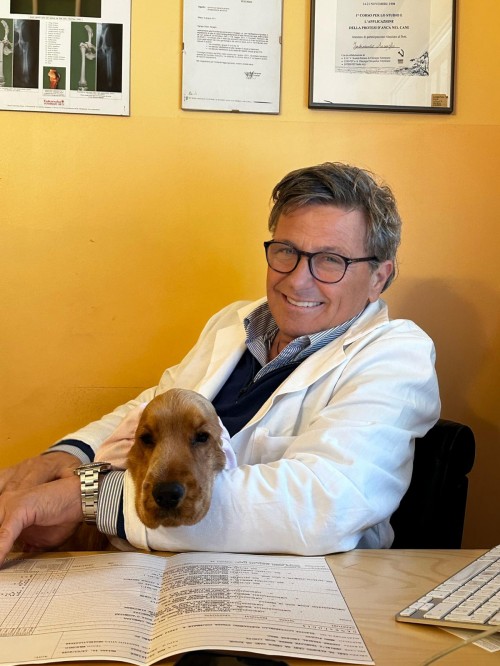published in "I Nostri Cani" official newspaper of Italian Kennel Club (ENCI)
THE DOG IS NOT A PAINTING by Dott. Ferdinando Asnaghi
An expert judge and VMD explains the "colour rebus". How to fight the bad practice of changing the coats thus infringing regulations. The tricks, the dyes, how to uncover doctoring.
Artificial colouring of dogs is prohibited! Yes... But... For some breeds it's customary... This is the reply given by some exhibitors, even piqued towards those expert judges who follow regulations to the letter. Let's analyse the problem with some common sense.
First of all let's take a look at what those regulations say. The FCI Antidoping rule is very clear "In the case of shows, measures that alter colour or structure of the skin, nose or coat are also prohibited". Furthermore, FCI rules for exhibition judges thus quotes"It is forbidden to prepare a dog with any substance that will alter the structure, colour or form of the coat, skin or nose. Only trimming, clipping, combing and brushing are allowed."
These FCI rules have been accepted by ENCI as well, thus it is clear that it is forbidden to colour or in any way tinge show dogs!
Notwithstanding the fact that this interdiction has been expressed in a very clear manner, the use of products to colour some show breeds is still widespread. Let us briefly analyse this phenomenon.
Tinted truffle: some individuals have dep pigmented noses which are coloured in various ways: the most common one is a bi-component tincture which gives the truffle a classic colour. It is very difficult to detect but for the fact that the truffle becomes a uniform dark grey colour, which is rarely found in nature.
Coloured coats: here we tread on a jungle of uses which vary from breed to breed. Tinges: these are products used on humans to colour their hair; nowadays they are also found for use on animals. For Poodles for example, appropriate tinctures are used: in the black variety, a deep black will give the coat a uniform appearance, but... it often reflects a blue hue which is rarely seen in nature. In the Black Schnauzers, the same tint will give the same colour, which will be more difficult to detect due to the breed's hard coat.
Generally, if tinges are done well before hand and in perfect manner, they are very difficult to be detected by the judge in the ring unless... a hair sample is collected to be analysed chemically. This is the case with some breed clubs, particularly sensitive to the problem, who have adopted this practice to be done on those individuals who win CACs at Specilties. It is a relatively simple test which triggers a chemical reaction to heat in a test tube where the sample hair has been dipped in a reagent, showing a positive colorimetric variation. In other words, a simple method which safeguards the non coloured dog.
Staying on tinctures, these are often used in other breeds such as the Yorkshire where the characteristical steel blue of the back is very difficult to select; in this case it is easy to check the hairs at the root looking for differences in hue (the famous re-growth!), unless the colouring is fresh.
Whiten white dogs: it is not easy to obtain and maintain a perfect white colour, especially in show dogs. So? So some individuals use specific products, both human and animal oriented, to de-colour the coat until it becomes a pristine white. Some creams, which exist in the US, if used 24 hours before the show will not only turn the coat white in certain critical spots, but will also correct skin which is not in perfect condition (I have personally used on Bassett Hounds, especially on the feet) in an incredible manner which is rarely detected visually but only through a chemical test. Another method used to whiten white dogs, if you allow the pun, is talcum powder or calcium carbonate and the latest American sprays which are very simple to use. All of these though leave is decibel traces on the judges hands, when he is examining the dog in question, unless they are set with hair spray, which is also forbidden and easily detectable.
Chalks and powders: these products pertain mainly to the Dachshund Group.
Chalks are coloured products presented in small squares, mainly black, tan and white which are used dry or damp directly on the dog's coat, giving it a perfect colouring for the breed; the powders are basically the same products presented in powder form. Furthermore, in those breeds with a harsh coat, they tend to harsher softer coats.
This practice, which began in the UK, was quickly adopted in the rest of the world. With the new rules though, they are all but forbidden. You might be judging an overall correct Jack Russell Terriers and find your hand coloured brown after examining its head or white after caressing his back: the dog is clearly coloured and should be disqualified as per regulations.
But why is it forbidden to colour dogs? The answer is very simple: dog shows are basically zoo technic gauges in which different individuals are judged by the phenotypic characteristics. If one of the is altered, as in this case the coat colour, the evaluation is automatically altered. Furthermore, coat colouring is a trait which is genetically transmissible, thus the exhibitors looking on the judging will have a distorted impression of the dog at hand with probable repercussions on the choice of a reproduction. Let's be frank, aspiring to win a dog show is absolutely legitimate but not in a devious way, putting in jeopardy the selection of the breed. Let's stop colouring dogs just because of a "Cup Syndrome". By Dott.Ferdinando Asnaghi FCI judge
published in "I Nostri Cani" official newspaper of Italian Kennel Club (ENCI)
